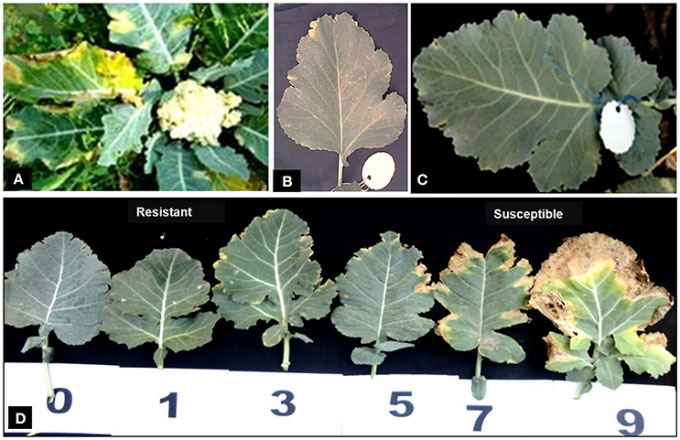Scientists in Singapore have identified how the bacterium known as the “winter vegetable killer” attacks at the molecular level and paralyzes the plant’s immune system.
Statistics show that between 2004 and 2013, numerous fields of cruciferous vegetables, including those grown in greenhouses, were attacked by a deadly bacterium, causing severe wilting, burning, and rotting of the leaves.

Common symptoms on cruciferous vegetables include broccoli, Brussels sprouts, cabbage, cauliflower, kale, etc. (Photo: MH)
During the winter in Turkey from 2004 to 2006, many fields of cabbage, broccoli, and Brussels sprouts were found to be blackened and wilting. This is also a plant disease that has been untreatable for over a century, threatening global food security.
However, a group of scientists in Singapore has, for the first time, identified how this bacterium, dubbed the “winter vegetable killer”, attacks at the molecular level and paralyzes the plants’ immune systems.
“The findings of our research group will pave the way for plant biologists to better manage infected crops and find ways for vegetables to resist deadly bacteria without using genetic engineering techniques,” said Professor Miao Yansong, Head of the Biology Department at Nanyang Technological University (NTU).
Professor Miao stated, “For some wicked diseases in agriculture, entire fields must be destroyed to completely eliminate the source of the disease. And in the pre-harvest stage, if bacteria are still hidden deep within the leaves and are found to be rotting, it will lead to significant losses for farmers.”
Professor Miao and his team discovered that the bacterium causing black rot, known as Xanthomonas, infiltrated harmful proteins into plant cells.
Although the surface of plant cells contains triggers for immune responses against diseases, these harmful proteins formed a sticky network that adhered tightly to the cell surface and attacked the plant’s protective mechanisms.

Cauliflower infected by Xanthomonas. (Photo: Getty)
Professor Miao noted, “Our research has enhanced knowledge of a previously unknown mechanism by which these harmful proteins damage plant cells.”
Based on this new discovery, scientists at Nanyang Technological University Singapore are creating a “toolkit” outlining new mechanisms, so plant biologists can begin working to help crops resist bacteria.
Accordingly, they may use new technologies or methods to create bacterial-resistant seedlings to combat black rot pathogens. “We hope it can lead to new solutions without the need for gene editing,” Professor Miao added.
Dr. Mandar Godge from the Plant Research Center at Temasek Polytechnic stated that this discovery could also help develop accurate diagnostic methods to identify diseases affecting crops and support new crop breeding programs.
In recent years, Singapore has established more urban farms to enhance food security. Although cruciferous vegetables such as broccoli and cabbage are more susceptible to black rot, this dangerous bacterium can also infect other leafy greens grown in Singapore.
Dr. Godge noted that there have been reports of black rot infections in various locally grown vegetables, such as bok choy, Chinese kale, lettuce, and kale. However, the economic impact of black rot on these leafy greens has yet to be fully documented.
Moreover, the warm and humid weather in the region is considered an ideal environment for Xanthomonas bacteria to thrive. Such bacteria, or related strains, have been found in pastures or fields and can spread in various ways, including through rain and wind.

Cabbage affected by black rot. (Photo: Getty)
Professor Miao stated, “Singapore has a wide variety of plant species, and some plants may facilitate the emergence of such bacteria. However, research and surveys on this plant disease remain limited.”
Although green vegetables are primarily grown in net houses and high-tech farms in Singapore, Xanthomonas bacteria can still infiltrate closed farms through air exchange or when workers inadvertently bring it in.
Professor Miao warned, “Indoor green farms have a lower chance of infection, but once it occurs, the bacteria can be retained within and may proliferate.”
What is black rot and its conditions of occurrence
Black rot is caused by a fungus and typically thrives and causes damage in wet weather conditions, with erratic rainy and sunny seasons, waterlogging, and high soil temperatures.
Initial symptoms include black cracks appearing on the stems, and later, the disease may appear on the leaves, showing light brown circular spots. Infected vegetable plants cannot grow due to the spreading rot encircling the above-ground stems, causing the plants to wilt and collapse.
Experts advise maintaining cleanliness in the fields before planting; treating seeds to eliminate fungi with chemicals before planting. When disease appears, early destruction is necessary. During the rainy season, it is advisable to create raised beds for good drainage and rotate with other non-cruciferous crops in these fields. Apply balanced fertilizers and regularly monitor the fields for timely interventions.


















































